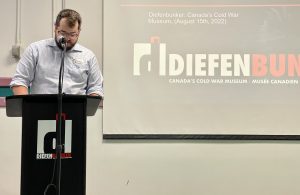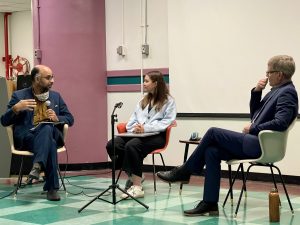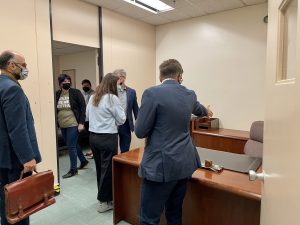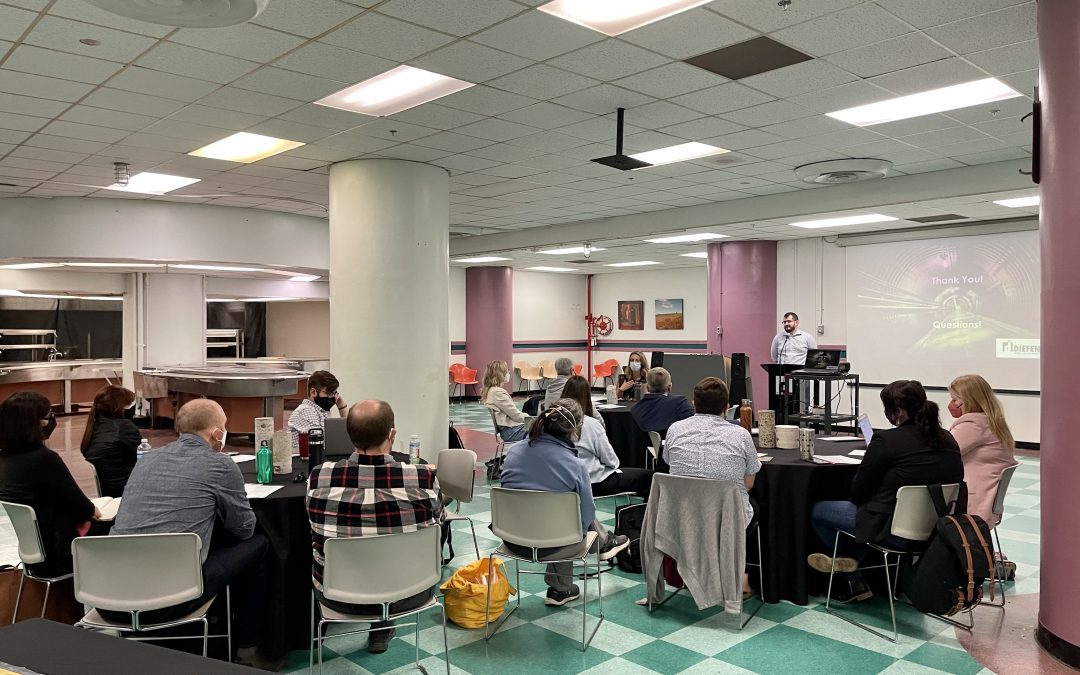Introduction
On Monday, August 15, 2022 and Tuesday, August 16, 2022, we were pleased to host a symposium at the Diefenbunker in partnership with Wilfrid Laurier University. Mapping the Cold War: The Spatialization of Preparedness brought multidisciplinary experts together to engage in thought-provoking discussions about their respective research and ongoing projects that relate to the Cold War.

Sean Campbell, Research and Collections Lead, amidst his presentation.
Commencing the workshop through welcome and land acknowledgment was the Diefenbunker’s Executive Director, Christine McGuire. Following suit was the Diefenbunker’s Research and Collections Lead, Sean Campbell, who provided an insightful and academic overview of the history of early civil defence in Canada during the Cold War. In his discussion, Campbell encouraged the audience to reflect upon the question: “if an attack on Canada happened tomorrow, would you feel prepared?” This question, coupled with Campbell’s informative talk, kickstarted engaging conversations among participants over the course of the two days.
Day One
Charlotte Woodley and Dr. Kevin Spooner

Pictured: (L-R): Dr. Inderbir Singh Riar, Charlotte Woodley, and Dr. Kevin Spooner discuss the adaptive reuse of architectural buildings.
Charlotte Woodley is an Archivist with the Region of Waterloo Museums and Archives. She covered topics that were under the scope of material cultures. Through her discussions of facilities, fallout shelters, and bunkers, Woodley delved into the heritage archaeology in the Region of Waterloo.
Dr. Kevin Spooner, the Director of the Laurier Centre for the Study of Canada, continued the discussion on material cultures through his viewpoints on how the Cold War gets commemorated and remembered in Canada. Dr. Spooner talked about preserving Cold War history through the adaptive reuse of heritage buildings. He discussed how converting said buildings into museums, art galleries, or community and event centres would be an adequate way in which Cold War heritage could be both preserved and safeguarded.
Between both Woodley and Dr. Spooner, and through the perceptive questions asked by Dr. Inderbir Singh Riar, a member of the Board of Directors for the Diefenbunker, they raised prevalent points on the repurpose and reuse of heritage sites and monuments in Canada.
Dr. Andrew Burtch and Dr. Matthew Farish

Pictured (L-R): Dr. Andrew Burtch, Dr. Sara Matthews, Dr. Matthew Farish, and Dr. Kevin Spooner discuss Building the Bunker.
Dr. Andrew Burtch is a Historian at the Canadian War Museum, with research interests in Canadian military history and Cold War culture. Pursuant to the topics of preservation and adaptive reuse, Dr. Burtch emphasised three stages of archival research: the discovery of archives; the discovery of the physical site/evidence; and the destruction of the site. Dr. Burtch also highlighted the importance of archives and discussed a series of fallout shelters in Manitoba.
Concluding day one of the symposium was Dr. Matthew Farish, an associate professor in the department of Geography and Planning with the University of Toronto. Dr. Farish wrapped up the discussion of material cultures by examining the Cold War, militarization and geopolitics, Arctic studies, and urban culture, all of which are areas in his academia and expertise.
Day Two
Skylee-Storm Hogan and Krista McCracken
Skylee-Storm Hogan, Public Historian, expressed their interest in community-based and Indigenous archival systems, ownership, and collections access. Hogan shared experiences from their research work to offer insights into the erasure of Indigenous Peoples and lands within preparedness, and into the colonial limitations of archives.
Krista McCracken is a Researcher/Curator at Algoma University’s Arthur A. Wishart Library and Shingwauk Residential Schools Centre, in Baawating (Sault Ste. Marie, Ontario). Their research focuses on community archives, Residential Schools, access, and outreach. Krista McCracken and Skylee-Storm Hogan have previously collaborated on numerous academic publishing projects. During the symposium, they both outlined a vision of a decolonized archive and they talked of rights to ownership, information, and history-making.
Dr. Sara Matthews

Symposium participants begin their tour of the Diefenbunker.
Dr. Sara Matthews, Communication Studies at Wilfrid Laurier University, focuses primarily on culture and conflict, aesthetic methods and research creation, and war museums and public education. In her talk, Dr. Matthews focused on her research in the Canadian War Museum’s archive on historic photos of the Distant Early Warning Line (DEW Line). She also discussed how she has navigated her work as a settler academic working on histories involving Indigenous Peoples.
Dr. Mary Kavanaugh and Julie Salverson
Dr. Mary Kavanaugh, Department of Art, University of Lethbridge, is a visual artist who explores the material evidence of war, weaponized landscapes, and the nuclear era in her practice. Dr. Kavanaugh added to the conversation on interpreting archives by discussing her work, Daughters of Uranium and Trinity³. These works break down the approach to nuclear history and they deal with how living things have interacted with the progression of nuclear research.
Julie Salverson, Dan School of Drama & Music, Queen’s University, is a writer, speaker, teacher, and workshop leader. Salverson discussed her current research, writing, and performance, including Canada’s involvement in the development of the atomic bomb, the role of the creative arts in military trauma, and the importance of the imagination in learning and development. She also discussed her approach to these topics in the form of pantomime and musicals while citing her opera Shelter, which is about the birth of the Atomic Age.
With their corresponding outlooks on the Cold War, Dr. Kavanaugh and Salverson partook in an engaging discussion on framing nuclear history within the realm of art and artistic interpretation.
Goharr Ashoughian and Mona Elayyan

Symposium participants explore the Prime Minister’s Suite.
Wilfrid Laurier University staff members, Gohar Ashoughian, Mona Elayyan, and Dr. Sara Matthews discussed their work on their partnered exhibition with the Diefenbunker, Canadian Cold War propaganda posters: Lessons from Bea Alerte and Justin Case. Dr. Matthews, as a part of her current five-year research project, approached the topic from the curatorial perspective and discussed how she found a direction and materials to create the exhibition.
Gohar Ashoughian, University Librarian, explained the background details of the project, including the importance of capturing and preserving metadata and maintaining the website framework.
Finally, Mona Elayyan, Digital Projects and Curation Librarian, explained the difference between digitization and digital humanities to the audience. They highlighted the importance of distinguishing between the two while creating projects like this.
Conclusion
This two-day symposium produced insightful discussions related to the Cold War. It was an informative event where scholars and experts were able to come together through their academia. The symposium ended with a pertinent point on cold and hot war, concluding that while concrete manifestations of a time period may dissipate, understanding the past through research, writing, and discussion will give us a greater understanding of the present and the future.
Learn more:
Charlotte Woodley: https://regionofwaterloomuseums.ca/Modules/contact/search.aspx? s=r03JAqLft45lA5HIgkCztOwRJAeQuAleQuAl
Dr. Kevin Spooner: https://www.wlu.ca/academics/faculties/faculty-of-arts/faculty-profiles/kevin-spooner/index.html
Dr. Inderbir Singh Riar: http://diefenbunker.ca/people/
Dr. Andrew Burtch: https://carleton.ca/history/people/andrew-burtch/
Dr. Matthew Farish: https://munkschool.utoronto.ca/profile/farish-matthew/
Skylee-Storm Hogan: https://www.alastore.ala.org/content/skylee-storm-hogan
Krista McCracken: https://kristamccracken.ca/?page_id=2
Mary Kavanaugh: http://www.marykavanagh.ca/bio.html
Julie Salverson: https://sdm.queensu.ca/julie-salverson/
Gohar Ashoughian: https://www.wlu.ca/news/spotlights/2021/oct/gohar-ashoughians-term-as-university-librarian-extended-for-one-year.html
Mona Elayyan: https://www.wlu.ca/academics/library/librarians.html
